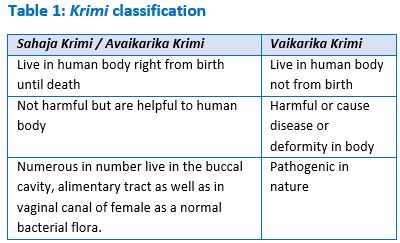Concept of Krimi and its scientific understanding
DOI:
https://doi.org/10.21760/jaims.8.6.26Keywords:
Krimi, Worm, Microbes, Helminthes, Abhyantara Krimi, Bahya KrimiAbstract
The term Krimi is frequently used in ancient Ayurveda classics from the Vedic period. In The etiology of many diseases, microbial relation played very important role and it is also a causative factor for various pathological condition like weight loss, Anemia, Vomiting, Headache etc. The Krimi may be external or internal in nature. Their mode of transmission, sign, symptoms are almost same as worm and microbes in contemporary science. They had given the description of structure, Naming of Krimi as far as possible. The Krimi described in ancient text are more or less similar to microbes and helminths mentioned in present time. The term Krimi has been used in broader sense. It indicates all pathogenic and non pathogenic organisms covering wide range of infectious pathogens. Ayurveda has advised specific drugs for specific Krimi. Here an effort has been made to understand the Krimi in all the ways possible.
Downloads
References
Sarkar M. Personal hygiene among primary school children living in a slum of Kolkata, India. J Prev Med Hyg 2013;54:153-8
Sitotaw B, Mekuriaw H, Damtie D. Prevalence of intestinal parasitic infections and associated risk factors among Jawi primary school children, Jawi Town, North-West Ethiopia. BMC Infect Dis 2019;19:341
WHO. Mortality and burden of disease 2010, World Health Statistics
Dev RK. Shabdakalpadruma. Vol. – 2. Varanasi: Chaukhamba Sanskrit Series Office; 1967. P. 178.
Shastri RG. Vedomain Ayurved. Delhi: Jamna Printing Works; 1956. P. 49.4) Kantadev R. Shabdhakalpadruma, 3rd edition, Chaukhambha Sanskrit Series Office, Varanasi, 1967; 178.
Kantadev R. Shabdhakalpadruma, 3rd edition, Chaukhambha Sanskrit Series Office, Varanasi, 1967; 178.
Tripathy BN. Charaka Samhita. Vol. – 1 (Sutra Sthana). Varanasi: Chaukhamba Surbharati Publication; 2013. P. 340.
Shastri RG. Vedomain Ayurved. Delhi: Jamna Printing Works; 1956. P. 55.
Tripathy BN. Charaka Samhita. Vol. -1 (Vimana Sthana). Varanasi: Chaukhamba Surbharati Publication; 2013. P. 711. 15.
Tripathy BN. Madhava Nidanam (Roga Viniscaya, Madhukosa). Vol. –I. Varanasi: Chaukhamba Surbharati Prakashan; 2014. P. 303. 16.
Tripathy BN. Charaka Samhita. Vol. -1 (Vimana Sthana). Varanasi: Chaukhamba Surbharati Publication; 2013. P. 713. 17.
Shastri AD. Susruta Samhita. Vol. –II. Varanasi: Chaukhamba Sankrit Sansthan; 2001. P.400. 18.
Tripathy BN. Charaka Samhita. Vol. -1 (Vimana Sthana). Varanasi: Chaukhamba Surbharati Publication; 2013. P. 712
Tripathy BN. Madhava Nidanam (Roga Viniscaya, Madhukosa). Vol. – I. Varanasi: Chaukhamba Surbharati Prakashan; 2014. P. 304.















